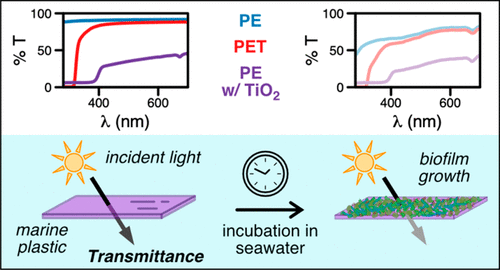当前位置:
X-MOL 学术
›
Environ. Sci. Technol.
›
论文详情
Our official English website, www.x-mol.net, welcomes your
feedback! (Note: you will need to create a separate account there.)
Product Formulation Controls the Impact of Biofouling on Consumer Plastic Photochemical Fate in the Ocean
Environmental Science & Technology ( IF 10.8 ) Pub Date : 2021-06-16 , DOI: 10.1021/acs.est.1c02079 Taylor F Nelson 1 , Christopher M Reddy 1 , Collin P Ward 1
Environmental Science & Technology ( IF 10.8 ) Pub Date : 2021-06-16 , DOI: 10.1021/acs.est.1c02079 Taylor F Nelson 1 , Christopher M Reddy 1 , Collin P Ward 1
Affiliation

|
The photodegradation rates of floating marine plastics govern their environmental lifetimes, but the controls on this process remain poorly understood. Photodegradation of these materials has so far been studied under ideal conditions in the absence of environmental factors such as biofouling, which may slow photochemical transformation rates through light screening. To investigate this interaction, we incubated different plastics in continuous flow seawater mesocosms to follow (i) the extent of biofilm growth on the samples and (ii) decreases in light transmittance through the samples over time. We used consumer products with high relevance (e.g., shopping bags, water bottles, and packaging materials) and with different formulations, referring to primary polymers (polyethylene (PE) and polyethylene terephthalate (PET)) and inorganic additives (titanium dioxide (TiO2)). The behavior of consumer-relevant formulations was compared to those of pure PE and PET films, revealing that the relative effects of UV- and, to a lesser extent, visible-light screening differ based on the formulation of the product. Pure PE showed greater relative UV-transmittance decreases (Δ = −34% through the entire sample, accounting for biofilm on both sides of the plastic film) than PET (Δ = −20%) and PE products with TiO2 (Δ = < −10%). Our results demonstrate that even with biofouling, photodegradation remains a highly relevant process for the fate of marine plastics. However, we expect photodegradation rates of plastics in the ocean to be slower than those measured in laboratory studies, due to light screening by biofilms, and the specific formulation of plastic products is a key determinant of the extent of this effect.
中文翻译:

产品配方控制生物污垢对海洋中消费塑料光化学命运的影响
漂浮海洋塑料的光降解率决定了它们的环境寿命,但对该过程的控制仍然知之甚少。迄今为止,在没有生物污垢等环境因素的理想条件下研究了这些材料的光降解,生物污垢可能通过光屏蔽降低光化学转化率。为了研究这种相互作用,我们在连续流动的海水中培养不同的塑料,以跟踪 (i) 样品上生物膜生长的程度和 (ii) 随着时间的推移,通过样品的透光率降低。我们使用具有高度相关性的消费品(例如,购物袋、水瓶和包装材料)和不同的配方,2 ))。将消费者相关配方的行为与纯 PE 和 PET 薄膜的行为进行比较,表明紫外线和可见光屏蔽的相对影响因产品配方而异。与 PET (Δ = -20%) 和含有 TiO 2 的PE 产品相比,纯 PE 显示出更大的相对紫外线透射率下降(整个样品中的 Δ = -34%,占塑料薄膜两侧的生物膜)(Δ = < -10%)。我们的结果表明,即使存在生物污垢,光降解仍然是与海洋塑料命运高度相关的过程。然而,由于生物膜的光屏蔽,我们预计海洋中塑料的光降解速率将比实验室研究中测得的速率慢,而塑料产品的特定配方是这种影响程度的关键决定因素。
更新日期:2021-07-06
中文翻译:

产品配方控制生物污垢对海洋中消费塑料光化学命运的影响
漂浮海洋塑料的光降解率决定了它们的环境寿命,但对该过程的控制仍然知之甚少。迄今为止,在没有生物污垢等环境因素的理想条件下研究了这些材料的光降解,生物污垢可能通过光屏蔽降低光化学转化率。为了研究这种相互作用,我们在连续流动的海水中培养不同的塑料,以跟踪 (i) 样品上生物膜生长的程度和 (ii) 随着时间的推移,通过样品的透光率降低。我们使用具有高度相关性的消费品(例如,购物袋、水瓶和包装材料)和不同的配方,2 ))。将消费者相关配方的行为与纯 PE 和 PET 薄膜的行为进行比较,表明紫外线和可见光屏蔽的相对影响因产品配方而异。与 PET (Δ = -20%) 和含有 TiO 2 的PE 产品相比,纯 PE 显示出更大的相对紫外线透射率下降(整个样品中的 Δ = -34%,占塑料薄膜两侧的生物膜)(Δ = < -10%)。我们的结果表明,即使存在生物污垢,光降解仍然是与海洋塑料命运高度相关的过程。然而,由于生物膜的光屏蔽,我们预计海洋中塑料的光降解速率将比实验室研究中测得的速率慢,而塑料产品的特定配方是这种影响程度的关键决定因素。











































 京公网安备 11010802027423号
京公网安备 11010802027423号